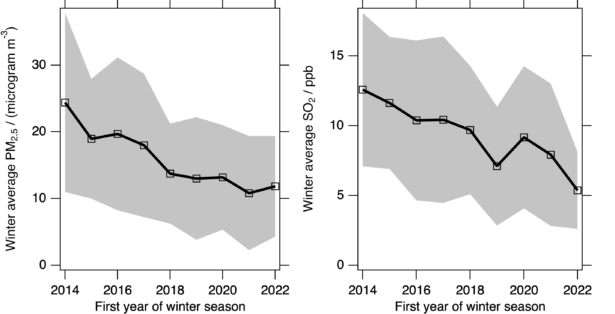By Bill Simpson
The Fairbanks North Star Borough has bad air quality in winter due to low winds and intense temperature inversions that trap locally generated pollution. We cannot control the weather, which leaves controlling local pollution sources as the only option to clean the air.
Cleaner air improves community health, as shown in epidemiological studies1 that demonstrate improved health outcomes as concentrations of fine particulate pollution, known as PM2.5, decline. In Fairbanks, a study2 showed significant associations between short-term PM2.5 exposure and hospital admissions, in agreement with the broader literature of effects of PM2.5 exposure.
In this column we compare historical and recent pollution measurements to see if local actions and regulations are working to clean our air. The measurements were made by the Alaska Department of Environmental Conservation as a part of the National Core (NCore) monitoring network funded by the U.S. Environmental Protection Agency.
The charts with this article show average concentrations of two pollutants at the downtown monitoring site in Fairbanks: sulfur dioxide gas, SO2, and the fine particulate matter, PM2.5.
The data shown are wintertime averages from November 1 of one year through Feb. 28 of the next year. The pollutants in these figures show significant downward trends over this period, demonstrating that air is getting cleaner through our community’s actions.
Considering what is working is helpful.
We know that wood smoke pollution is a large component of the PM2.5 we breathe, so the State Implementation Plan developed by the Department of Environmental Conservation has a multi-pronged effort to reduce wood smoke. This plan applies within the EPA-designated nonattainment area, which is divided into Fairbanks and North Pole zones, maps of which are available on the Fairbanks North Star borough website. These efforts include wood stove change-out and replacement programs, educational campaigns, measures to support burning drier wood and air alerts on the most stagnant days of the winter. These air alerts require residents of the affected zone to not use cordwood and pellet stoves on the bad air days unless they have no other source of heat.
At the downtown site in Fairbanks, winter average PM2.5 concentrations have substantially reduced. Since 2014, average PM2.5 concentrations dropped over 40%, a healthy reduction. At the more-residential monitoring site at Hurst Road, the peak daily PM2.5 concentrations have been cut in half, but the problem was so bad there that it still is over the EPA 24-hour standard.
When fuels containing sulfur are burned, they produce the gas SO2 and sulfuric acid, which condenses in the atmosphere, increasing PM2.5 mass concentrations. You can see evidence of this acid in the orange rust on your oil boiler chimney flashing and possibly holes in your metal roof.
To reduce the sulfur in PM2.5 particles, the state air quality plan included a regulation to change from the high-sulfur No. 2 heating oil to the lower sulfur No. 1 oil. This regulation came into effect in fall 2022. The choice was made to go to No. 1 instead of ultra-low sulfur diesel because the cost difference between No. 2 and No. 1 was nowhere near as large as the change to ultra-low sulfur diesel. Fuel prices are important because increasing the cost of heating is likely to drive people to burn more wood, worsening pollution.
The main immediate product of combustion of sulfur in heating oil is SO2, and the chart shows that this has reduced to about half the 2014 levels. SO2 is also a pollutant regulated under the clean air act, and although the Fairbanks borough does not violate EPA standards, SO2 may have health effects at below-regulation levels, so the observed reduction in SO2 may improve health.
Although the SO2 reduction tells us the fuel cleanup is working, the end goal of the fuel swap was to lower PM 2.5 mass concentrations by reducing the sulfur we find in those particles. These PM2.5 sulfur species are measured from filter samples that take months to be analyzed, so we don’t yet know how much PM2.5 sulfur has improved. We will be examining those data as soon as they are available.
The evidence shows that what we are doing to clean up pollution in the Fairbanks North Star Borough is working.
Bill Simpson is an air quality researcher from UAF. This work was funded by the National Science Foundation.
References:
1 Laden, F., Schwartz, J., Speizer, F. E., & Dockery, D. W. (2006). Reduction in fine particulate air pollution and mortality: extended follow-up of the Harvard Six Cities study. American journal of respiratory and critical care medicine, 173(6), 667-672.
2 Kossover, R.: Association between Air Quality and Hospital Visits — Fairbanks, 2003–2008, State Alaska Epidemiol. Bull., 1 [online] Available from: https://dec.alaska.gov/media/18043/cfca-ej-sc-comments-attachment-g-adhhs-epidemiology-bulletin-fbx-air-quality-and-hospital-visits.pdf, (Accessed 26 January 2023), 2010.


